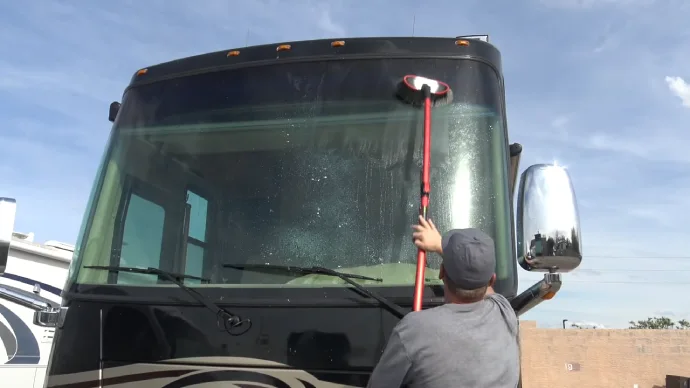Last Updated on May 2, 2023
If you’re an avid RV enthusiast, you know just how important it is to keep your vehicle clean and well-maintained. However, one of the most frustrating challenges of owning an RV is dealing with the pesky bugs that stick to the windshield after a road trip.
Not only do they obstruct your view, but they can also damage your windshield if not removed properly. Spraying bug remover spray liberally on the RV windshield will easily remove bugs.
Through this article, we’ll explore some effective ways to clean bugs off RV windshields without causing any harm to your vehicle. So buckle up and let’s get started.
How to Clean Bugs Off RV Windshield: Easy Steps
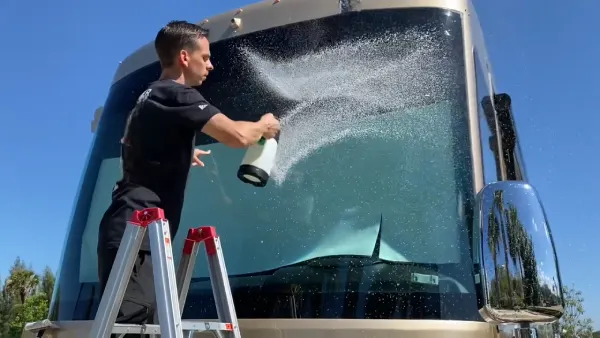
Cleaning bugs off your RV windshield can be challenging, but it’s essential for maintaining the safety and appearance of your vehicle. Here are the steps to get rid of those pesky bugs and keep your windshield looking clean and clear.
Step 1: Preparing the Windshield
Properly preparing the surface beforehand is essential to clean bugs off your RV windshield effectively. This will make the cleaning process easier and prevent any damage to the glass.
First, park your RV in a shaded area or wait until early morning or late evening when the windshield is cooler. Cleaning a hot windshield can cause the cleaning solution to evaporate too quickly, leaving behind streaks and residue.
Step 2: Applying Bug Remover Spray
Applying bug remover spray is essential when cleaning bugs off your RV windshield. Bug remover spray is specifically designed to break down and dissolve the proteins found in bug remains, making them easier to wipe away.
Once you’ve prepared your windshield by wetting it with water from the hose, apply the bug remover spray generously to the affected areas. Be sure to follow the manufacturer’s instructions for application and allow the product to sit for a few minutes so that it has time to work its magic.
Step 3: Wiping Away Dead Bugs
After applying bug remover spray to loosen up the dried-on insects, you’ll need to remove them from the windshield’s surface physically.
You’ll want to use a microfiber towel or sponge that won’t scratch or damage the glass. Begin by gently wiping away as many of the dead bugs as possible. Be sure to apply enough pressure to remove them without scratching the glass, but not so much that you risk damaging any coatings or tinting on the windshield.
If you encounter particularly stubborn bugs that won’t come off with just a simple wipe, try using a plastic scraper or credit card to scrape them away gently. It’s important to note that leaving dead bugs on your RV windshield for an extended period can lead to etching and damage to the glass.
Step 4: Rinsing with Water Hose
After applying the bug remover spray and wiping away the dead bugs from your RV windshield, it’s time to rinse the windshield with a water hose. This step is crucial to ensure that all the residue and dirt are removed from the surface of your windshield.
Start by using a moderate amount of water pressure to rinse off any remaining bug debris. Make sure you cover every inch of the windshield, paying special attention to areas where there may be more buildup, such as around the edges and near the wiper blades.
Step 5: Drying and Polishing with Glass Cleaner
After rinsing off the bug remover spray from your RV windshield, you must dry and polish the surface to prevent streaks and maintain clarity. You’ll need a clean microfiber towel and a quality glass cleaner for this step.
First, use a dry microfiber towel to blot any excess water from the windshield gently. Be careful not to rub too hard, or you may scratch the surface. Next, apply the glass cleaner directly onto another clean microfiber towel. Avoid using paper towels or rough cloths that can leave scratches on the glass.
Starting at the top of the windshield, wipe in a circular motion, gradually working your way down to the bottom. Make sure to cover all windshield areas, including corners and edges.
Tools and Materials Needed for Cleaning Bugs Off RV Windshield
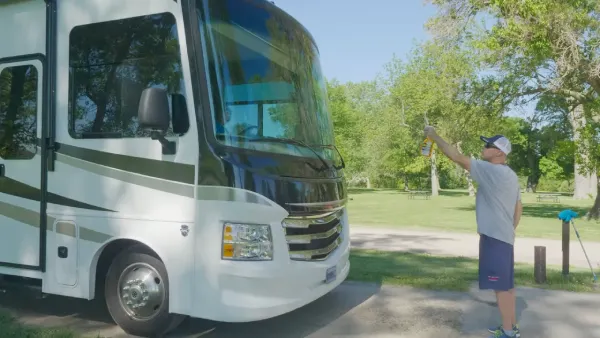
When removing bugs off your RV windshield, having the right tools and materials can make all the difference. Here are some of the essential items you’ll need to get the job done:
Microfiber Towels
Microfiber towels are an essential tool for cleaning bugs off your RV windshield. These towels are made of a blend of polyester and polyamide, which makes them highly absorbent and effective in removing dirt and grime without leaving any streaks or scratches on the glass surface.
When selecting microfiber towels for cleaning your RV windshield, choosing high-quality ones specifically designed for this purpose is important. Avoid using regular cotton towels or rags, as they can leave lint and debris on the glass surface, making cleaning harder.
Bug Remover Spray
Bug remover spray is essential for cleaning bugs off RV windshields. It is specially formulated to break down and dissolve the harsh, dried-on bug residue that can accumulate on your windshield during long trips. A quality bug remover spray can save time and effort when cleaning your RV’s windshield.
When choosing a bug remover spray, look for one that is safe for use on glass surfaces and will not damage your RV’s paint or decals. Many different brands are available on the market, so it’s essential to read the labels carefully and choose one that meets your needs.
Glass Cleaner
When washing bugs off your RV windshield, using a glass cleaner is an essential step in the process. After rinsing away the bug remover spray and dead bugs with a water hose, it’s essential to dry and polish the windshield with a quality glass cleaner.
Many different types of glass cleaners are available on the market, but choosing one specifically designed for automotive use is essential.
Also, look for a streak-free product safe for tinted windows if your RV has them. Some popular options include Invisible Glass, Stoner Car Care’s Invisible Glass Cleaner, and Meguiar’s Perfect Clarity Glass Cleaner.
Water Hose
The water hose helps in rinsing off the bug remover spray and dead bugs from the windshield. Using a hose with a nozzle that can control the water pressure is essential.
Why Cleaning Bugs Off RV Windshields Is Important?
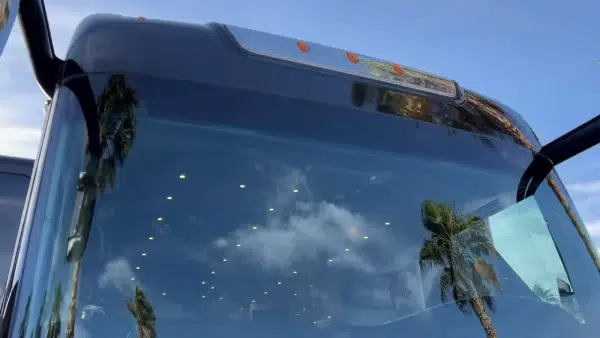
Cleaning bugs off your RV windshield is an essential task that should not be overlooked. If left unattended, the accumulation of dead insects can cause damage to the windshield and reduce visibility while driving.
Here are some reasons why you should clean your RV windshield:
Preventing Damage to Windshield
The windshield of your RV is an essential component that protects you from the elements while driving. Bugs left on your windshield for an extended period can cause pitting and etching on the glass surface.
Their bodies contain acidic compounds that can corrode the glass if left untreated. Over time, this damage can result in cracks or chips in the windshield, which may require expensive repairs or replacements.
Avoiding Reduced Visibility
Reduced visibility while driving your RV can be a major safety hazard, especially if you are traveling at high speeds on the highway.
Bugs splattered across your windshield can make it difficult to see the road ahead, increasing the risk of accidents. Keeping your RV windshield clean and clear of bugs is essential.
Bugs can leave behind acidic substances that can corrode and damage your windshield over time. If left unattended, these substances can cause pitting and cracking on the surface of the glass, compromising its structural integrity. Regular cleaning is essential to prevent this kind of damage.
Maintenance Tips to Keep Windshield Clean and Clear of Bugs
A clean, clear windshield allows unobstructed visibility, ensuring you can easily navigate all driving conditions. However, maintaining the windshield can be quite challenging, especially during summer when bugs and other debris can stick to the glass.
Using a Quality Bug Screen on Your RV
A bug screen is a mesh material that covers the front of your RV and acts as a barrier between your windshield and any bugs or debris that may come your way. It’s designed to catch insects and other small particles before they hit your windshield, reducing the damage they can cause.
Using a quality bug screen has many benefits. First, it protects your windshield from scratches, chips, and cracks caused by flying debris. This can save you hundreds or even thousands of dollars in repair costs.
Secondly, it makes cleaning your windshield much easier. With a bug screen, you’ll have fewer dead bugs to clean off your windshield after each trip. This means less time spent scrubbing away at stubborn stains and more time enjoying the open road.
Finally, a bug screen can improve your visibility while driving. When there are fewer bugs splattered across your windshield, you’ll be able to see more clearly and react more quickly to any potential hazards on the road.
Regularly Cleaning Your RV’s Front End
Cleaning the front end of your RV is essential to maintaining its appearance and functionality. The front end includes the windshield, grille, headlights, and other areas prone to collecting dirt, grime, and bugs while on the road. Regular cleaning helps keep your RV looking great and prevents damage to the vehicle’s exterior.
Use a Bug and Tar Remover
One of the most effective ways to clean your windshield is by using a bug and tar remover. During the summer, bugs splatter on the windshield, leaving behind sticky remains that can be challenging to remove. Most of the time, regular cleaning solutions won’t remove them.
Using a bug and tar remover not only helps to dissolve the bug remains but also removes any tar and road grime. To use a bug and tar remover, apply the solution on a clean cloth and rub gently on the affected areas. Always use a microfiber cloth to avoid scratching the windshield.
Avoid Parking Under Trees
Another practical maintenance tip is to avoid parking under trees. While parking under trees may seem like a good idea to keep your car cool during hot weather, it can harm your windshield’s health. Tree sap and bird droppings can stick onto the windshield, leaving behind stubborn stains that are difficult to remove.
Moreover, branches and twigs can fall from trees, causing chips, cracks, and even shattering the windshield. It is always best to park your car in a covered area, away from vegetation.
How do I get dried bugs off my RV windshield?
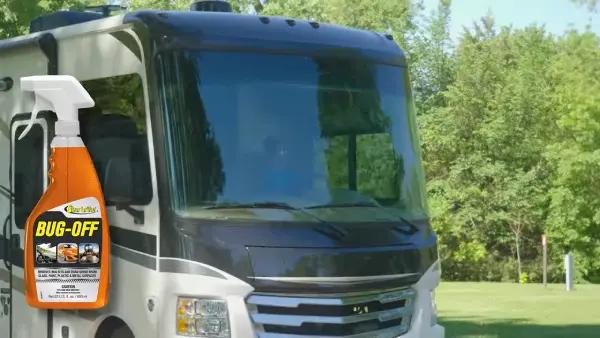
Removing dried bugs from your RV windshield can be an arduous task. However, there are various methods to make this process more manageable. One of the easiest and most effective ways is to soak the bugs with either warm water or vinegar.
If you choose to use water, it’s best to use warm water, which softens the dried bugs and makes them easier to remove. Simply soak a cloth in warm water and place it over the bugs on your windshield.
Leave it there for a few minutes to allow the warmth to soften the bugs, then use a soft-bristle brush to scrub them off gently. Be careful not to scratch your windshield during this process.
Can I use hydrogen peroxide for bugs on the RV windshield?
You can use hydrogen peroxide for bugs on your RV windshield. However, it is best to dilute it with equal water to prevent damage to your windshield. The ideal solution is a 50/50 mix of peroxide and water.
The combination of hydrogen peroxide and water helps to break down the bug’s exoskeleton and make it easier to remove. Simply pour the solution onto the dried bugs on your RV windshield and let it sit for five to ten minutes. Afterward, use a soft-bristled brush or cloth to scrub the bugs off gently.
Clean Up with Confidence: Simple Steps to Keep Your RV Windshield Clear and Unblemished
Cleaning bugs off the RV windshield is an essential task every RV owner should take seriously. Not only does it prevent damage to your windshield, but it also ensures clear visibility while driving.
Following the steps outlined in this article and using the necessary tools and materials, such as microfiber towels, bug remover spray, glass cleaner, and a water hose, you can quickly and easily clean the bugs off your RV windshield.
Also, maintaining a clean windshield can be achieved by regularly cleaning your RV’s front end and using a high-quality bug screen on your RV. These simple yet effective tips will keep your windshield in shape for years.
So don’t wait until your windshield is covered in bugs before taking action; follow these maintenance tips and regularly clean your RV’s windshield.

